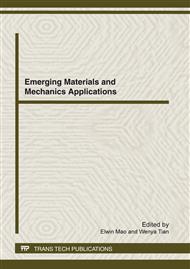[1]
A. Fujishima, Rao T. N., Tryk D. A. Titanium dioxide photocatalysis[J]. Journal of Photochemistry and Photobiology C: Photochemistry Reviews, 2000, 1(1): 1-21.
DOI: 10.1016/s1389-5567(00)00002-2
Google Scholar
[2]
M. R. Hoffmann, Martin S. T., Choi W., Bahnemann D. W. Environmental Applications of Semiconductor Photocatalysis[J]. Chemical Reviews, 1995, 95(1): 69-96.
DOI: 10.1021/cr00033a004
Google Scholar
[3]
C. S. Turchi, Ollis D. F. Photocatalytic degradation of organic water contaminants: Mechanisms involving hydroxyl radical attack[J]. Journal of Catalysis, 1990, 122(1): 178-192.
DOI: 10.1016/0021-9517(90)90269-p
Google Scholar
[4]
X. Chen, Mao S. S. Titanium Dioxide Nanomaterials: Synthesis, Properties, Modifications, and Applications[J]. Chemical Reviews, 2007, 107(7): 2891-2959.
DOI: 10.1021/cr0500535
Google Scholar
[5]
P. Wang, Huang B., Qin X., Zhang X., Dai Y., Wei J., Whangbo M. -H. Ag@AgCl: A Highly Efficient and Stable Photocatalyst Active under Visible Light[J]. Angewandte Chemie International Edition, 2008, 47(41): 7931-7933.
DOI: 10.1002/anie.200802483
Google Scholar
[6]
J. Yu, Dai G., Huang B. Fabrication and Characterization of Visible-Light-Driven Plasmonic Photocatalyst Ag/AgCl/TiO2 Nanotube Arrays[J]. The Journal of Physical Chemistry C, 2009, 113(37): 16394-16401.
DOI: 10.1021/jp905247j
Google Scholar
[7]
Y. Zang, Farnood R. Photocatalytic activity of AgBr/TiO2 in water under simulated sunlight irradiation[J]. Applied Catalysis B: Environmental, 2008, 79(4): 334-340.
DOI: 10.1016/j.apcatb.2007.10.019
Google Scholar
[8]
C. He, Gu M. Photocatalytic activity of bismuth germanate Bi12GeO20 powders[J]. Scripta Mater, 2006, 54(7): 1221-1225.
DOI: 10.1016/j.scriptamat.2005.12.028
Google Scholar
[9]
K. -L. Zhang, Liu C. -M., Huang F. -Q., Zheng C., Wang W. -D. Study of the electronic structure and photocatalytic activity of the BiOCl photocatalyst[J]. Applied Catalysis B: Environmental, 2006, 68(3-4): 125-129.
DOI: 10.1016/j.apcatb.2006.08.002
Google Scholar
[10]
Z. Deng, et al. Strong blue photoluminescence from single-crystalline bismuth oxychloride nanoplates[J]. Nanotechnology, 2008, 19(29): 295705.
DOI: 10.1088/0957-4484/19/29/295705
Google Scholar
[11]
H. An, Du Y., Wang T., Wang C., Hao W., Zhang J. Photocatalytic properties of BiOX (X = Cl, Br, and I)[J]. Rare Metals, 2008, 27(3): 243-250.
DOI: 10.1016/s1001-0521(08)60123-0
Google Scholar
[12]
H. Deng, Wang J., Peng Q., Wang X., Li Y. Controlled Hydrothermal Synthesis of Bismuth Oxyhalide Nanobelts and Nanotubes[J]. Chemistry – A European Journal, 2005, 11(22): 6519-6524.
DOI: 10.1002/chem.200500540
Google Scholar
[13]
C. Wang, Shao C., Liu Y., Zhang L. Photocatalytic properties BiOCl and Bi2O3 nanofibers prepared by electrospinning[J]. Scripta Mater, 2008, 59(3): 332-335.
DOI: 10.1016/j.scriptamat.2008.03.038
Google Scholar
[14]
F. Chen, Liu H., Bagwasi S., Shen X., Zhang J. Photocatalytic study of BiOCl for degradation of organic pollutants under UV irradiation[J]. Journal of Photochemistry and Photobiology A: Chemistry, 2010, 215(1): 76-80.
DOI: 10.1016/j.jphotochem.2010.07.026
Google Scholar


